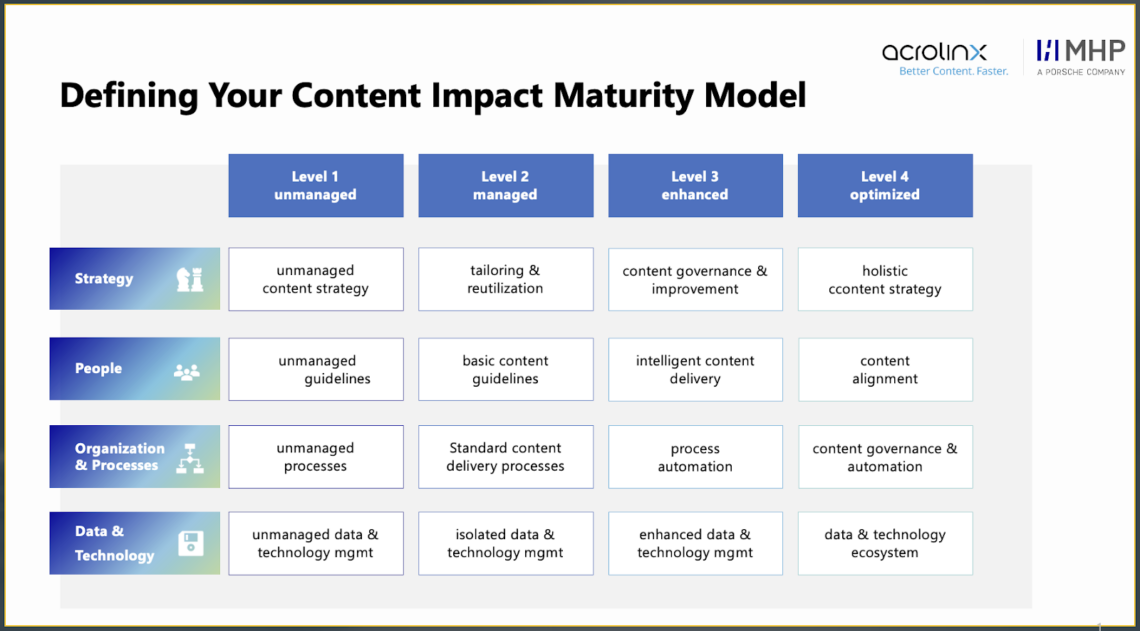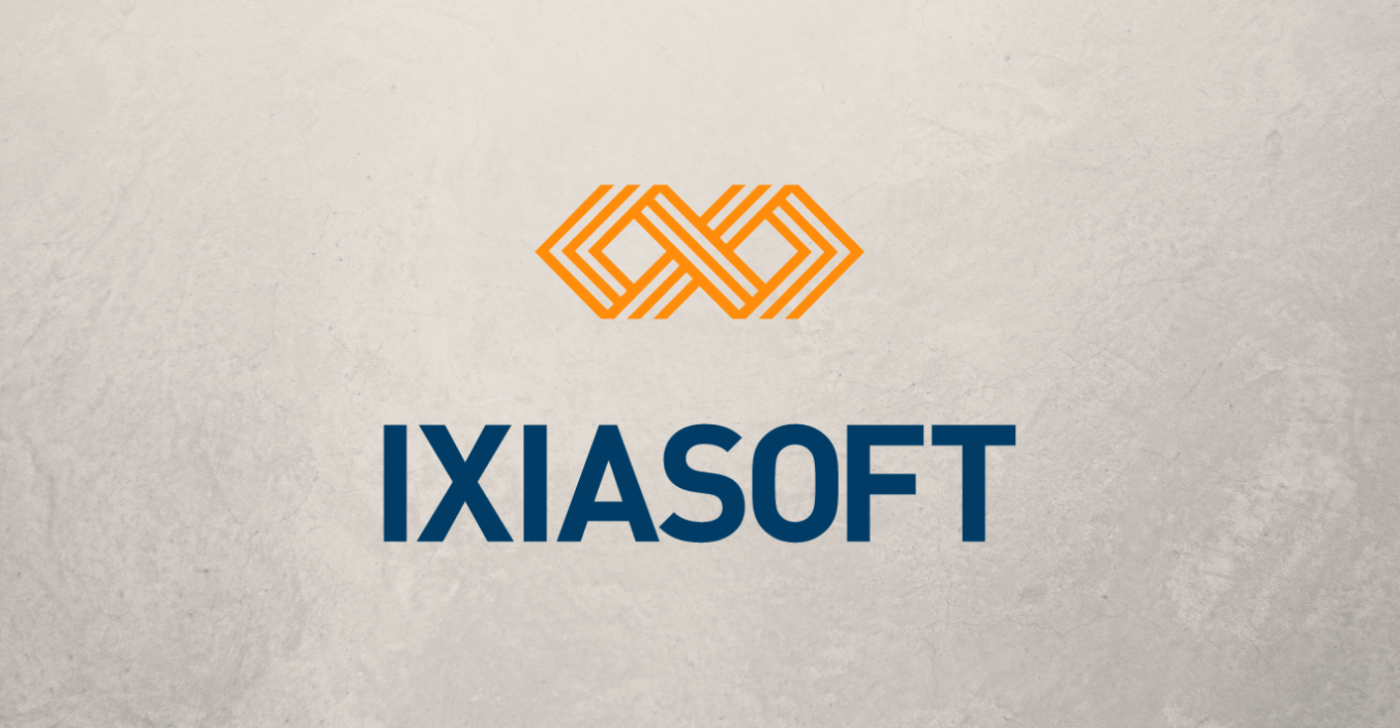Content marketing has evolved dramatically over the 20 years Acrolinx has been helping businesses to improve their enterprise content. But despite how far it’s come, brands continue to struggle with a key challenge: how to unify content creation, content strategy, content governance, and content marketing in one overarching, aligned approach.
In our experience, there are teams that know how to create structured content and build efficient processes and then there are teams that understand how to make content impactful for their audience. What they need is a common language and framework, but where to start? What should be the measures of success? What milestones and objectives should brands be setting themselves and which stakeholders should be involved?
Creating a framework for better content outcomes
That’s where Acrolinx partner MHP (www.mhp.com/newsroom) can help.
MHP is a global management and IT consultancy and subsidiary of the famous Porsche automotive company. Its 3500 consultants have deep process-related and digital expertise that MHP uses to serve a variety of sectors, including the automotive and manufacturing sectors. It provides management consulting, systems integration, application management, and business solutions to improve its customers’ processes throughout their value chains.
By partnering with MHP, we’re able to offer our customers an even broader set of service capabilities. These include mapping the business case for change for organizations considering investing in the Acrolinx platform, advising current customers on how to improve their content maturity, and delivery and implementation support.
I was fortunate to collaborate recently on a project with Lisa Dirscherl, Customer Experience Strategy Consultant at MHP, and her team. The project involved a variety of brands, departments, editorial systems, and processes, and the client had complex requirements, including:
- Ensuring consistent use of terminology and style guidelines
- Measuring content quality and improvement
- Software compatibility across different editorial systems
- Streamlining content creation and delivery processes
- Legal compliance
To help assess the client’s maturity across these key areas and consider how to help meet them, the project team developed a comprehensive framework based on our technology: the Content Impact Maturity Model.
Working with Acrolinx, MHP has made this model available to help other businesses better align their content creation, strategy, governance, and marketing.
About the model
The Content Impact Maturity Model takes a holistic view of content creation with two goals in mind: producing more effective content, and producing content more efficiently. It focuses on four aspects of the content creation process:
- Strategy
- People
- Organization and processes
- Data and technology
It assesses an organization’s maturity, rating it on a scale of 1 to 4 in each of these areas.

As Lisa explained during a recent webinar we ran together, “The aim of the model is to determine which level you are, where you want to be, and how we can help you to achieve your ideal position.”
MHP has strategies for increasing organizational maturity, as well as guidance on how to optimize performance.
A brand with “Level 2” maturity for content strategy, for example, could expect to produce content that’s tailored to specific audiences, consistent, and error-free.
In this instance, MHP would work closely with the brand to help it move to Level 3, which Lisa says is “defined by the ability to analyze the quality and impact of content and improve it if necessary,” or even Level 4, where you have a “holistic content strategy, covering different content types, departments, and divisions.”
Many of MHP’s strategies for progressing through the model’s levels are underpinned by elements of the Acrolinx platform. For example, brands can use Acrolinx to define how they want to communicate with their audiences across areas ranging from spelling and grammar to clarity, preferred terminology, tone of voice, and inclusive language. They can create distinct style guides for different types of content, audiences, or user groups, or specify nuances for groups within an overarching style guide. We call these Acrolinx Targets.
Acrolinx can be integrated with more than 50 authoring environments, including Google Docs, the G Suite, the Microsoft 365 suite, and XML editing environments. This means that organizations that have aligned their content across all departments and content channels can deliver consistent, error-free content at scale.
Using automation to drive efficiency
MHP’s Content Impact Maturity Model also looks at the processes organizations use to create content.
“Here, we usually start at Level 2, because businesses often have certain standard processes already in place,” explains Lisa. “The aim is to automate processes, at least partially, to reach Level 3.’’
“Level 4 is where a business has automated processes where possible, has full control over where it delivers content, and can track how the content performs. At Level 4, we would look at not only what technology is needed and how it should be integrated into the existing IT landscape, but also what skills, roles, and processes are required.”
Acrolinx can also help with optimizing processes. We know that every organization has a hub where content is managed or stored. Using our platform, organizations can run a batch check on stored content to identify material that may be below par and in need of review before publishing – without needing to open files manually. When a new piece of content is uploaded to the hub, it can be configured to trigger an automated check.
Using data to monitor quality and performance
The final aspect of the content creation process that the Content Impact Maturity Model covers is data and technology. This relates to how brands extract data from the content they create to measure and improve its quality in relation to criteria such as inclusive language and clarity. The goal here is to create a data technology ecosystem.
According to Lisa, “This would allow detailed KPI reporting at an organizational level, showing whether the content strategy is being implemented effectively. It also shows whether, or where, the strategy or content might need to be adjusted.”
Using Acrolinx, an organization can see whether an unpublished piece of content aligns with its standards and goals. It can also analyze published content, enhancing the Acrolinx scoring with a variety of post-production analytics, to see how it stacks up against those standards and goals, and identify pieces that could be improved.
To find out more about The MHP Content Impact Maturity Model for Acrolinx, and how it can help your business, please view our on-demand webinar here.


